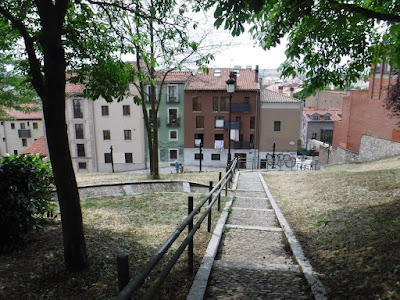Before heading back home from Burgos, I decided to spend an extra two days exploring the city by foot allowing me to discover several remarkable places. Here's an account of my experiences in Burgos.
I felt extremely fortunate to be able to stay at the same Albergue. The two elderly gentlemen at the front desk were very welcoming, although one of them appeared rather stern and slightly intimidating.
Upon my initial check-in, they inquired whether I preferred an upper or lower floor. I mistakenly thought they were referring to the type of bed. So, I expressed my preference for a bottom of the bunk, which led them to assign me to the 2nd floor (the first sleeping floor), with a bottom bunk located right by the door. I had actually intended to request a bed on the top floor, but my Spanish phrasing didn't convey this properly. I found the lower floor to be noisy due to constant foot traffic. After taking a stroll around town and returning to the Albergue, I resorted to Google Translate to compose a message and show them the translation. This time, they understood my desire for a bed on the top floor, which is much quieter. Consequently, they reassigned me to the 5th floor, where I had the entire space to myself until late when Ali, a previous roommate with whom I'd shared a room alongside Rita, arrived. Over the next two days, each time I returned for check-in, the staff members remembered me and graciously reassigned me to the same bed.
The Albergue's proximity to the Burgos Cathedral allowed me to easily reach and appreciate the cathedral's architectural intricacies up close. Right next to it stands the Church of San Esteban, Burgos, which I also had the chance to visit.
From there, I strolled to Plaza Mayor, Arco de Santa Maria, and the adjacent park. In the evening, I went out to the Plaza for dinner with my follow pilgrim Hanneke, a walker from Danmark. We tasted different tapas at two different places and had lots of fun.
Burgos Cathedral
Me with Hanneke
===============================================================*Burgos Cathedral
Designated as an UNESCO World Heritage Site in 1984, Burgos Cathedral also known as the Cathedral of Saint Mary of Burgos (Catedral de Santa María de Burgos), is one of the most stunning and iconic religious buildings in Spain. It is a masterpiece of Gothic architecture and holds a prominent place in the historic and cultural heritage of the city of Burgos.
The construction of Burgos Cathedral began in 1221 and continued over several centuries, with various additions and modifications. It was built on the site of an older Romanesque cathedral.
The cathedral is a prime example of French Gothic architecture and is renowned for its intricate design and elaborate ornamentation. It features soaring spires, pointed arches, ribbed vaults, and beautiful stained glass windows. The cathedral's exterior is adorned with numerous sculptures and statues, depicting a wide range of religious and historical figures. The intricate facade and towers are particularly striking and are a testament to the skill and craftsmanship of the artisans who worked on the cathedral.
**The Church of San Esteban
The Church of San Esteban features a combination of architectural styles, including Romanesque and Gothic elements. Its exterior is characterized by intricate stonework, and the interior boasts beautiful stained glass windows and impressive vaulted ceilings.
The church origins dating back to the 13th century. It has undergone various renovations and additions over the centuries, reflecting different architectural influences.

































































